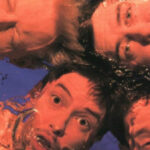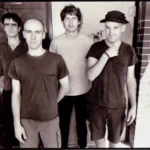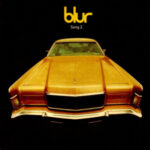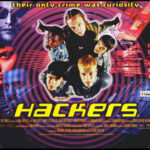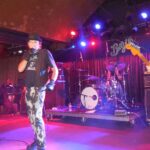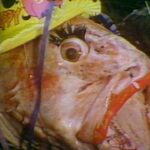 In the late 1970s, Los Angeles was a sprawling, sun-soaked metropolis where rock music’s commercial sheen dominated the airwaves. But beneath the surface, a handful of young outcasts were disillusioned with the predictability of mainstream culture. Among them was a ragtag group that would eventually form one of the most influential punk bands in the city’s burgeoning underground scene: The Germs. Despite their short lifespan and chaotic reputation, The Germs helped catalyze the L.A. punk movement, leaving a legacy that would endure long after their implosion.
In the late 1970s, Los Angeles was a sprawling, sun-soaked metropolis where rock music’s commercial sheen dominated the airwaves. But beneath the surface, a handful of young outcasts were disillusioned with the predictability of mainstream culture. Among them was a ragtag group that would eventually form one of the most influential punk bands in the city’s burgeoning underground scene: The Germs. Despite their short lifespan and chaotic reputation, The Germs helped catalyze the L.A. punk movement, leaving a legacy that would endure long after their implosion.
Beginnings: The Birth of The Germs
The Germs’ story begins in the mid-1970s with two friends, Jan Paul Beahm and Georg Ruthenberg, later known by their stage names, Darby Crash and Pat Smear. Both were high school dropouts and misfits who bonded over a shared love of music and disdain for societal norms. Their school, University High in West Los Angeles, was more of a breeding ground for troublemakers and eccentrics than a conventional institution. It was here that Darby and Pat conceived the idea of starting a band, even though neither had any formal musical training. This lack of technical ability would soon become part of their appeal.
The initial version of the band, originally called “Sophistifuck and the Revlon Spam Queens,” was more of an inside joke than a serious venture. But in 1977, they pared down the name to The Germs and solidified the lineup with drummer Don Bolles and bassist Lorna Doom. The Germs, now complete, began to form a distinctive sound and aesthetic: raw, aggressive, and deeply rebellious.
At the heart of the band was Darby Crash. His stage persona was magnetic, unpredictable, and confrontational. Inspired by anarchic figures like Iggy Pop, Crash’s performances were often marred by self-inflicted injuries, wild antics, and a chaotic disregard for his audience’s safety. While many saw him as erratic, those close to him recognized a kind of self-destructive genius in his approach. Lyrically, Crash was philosophical, his words often reflective of his turbulent inner life and disillusionment with modern society. In stark contrast, Pat Smear’s guitar work was less nihilistic. Though it was often amateurish in execution, Smear’s jagged riffs and distorted chords provided the perfect counterpoint to Crash’s frenetic vocals.
Early Performances: Chaos and Infamy
From their earliest shows, The Germs built a reputation as a band that played on the edge of chaos. Their live performances were legendary for being unpredictable and often dangerous. Many ended prematurely due to fights, Darby’s erratic behavior, or simply because the band members were too intoxicated to continue. Venues would frequently refuse to book them after one disastrous show, only for another to take the risk after hearing tales of their wildness. Yet, amidst this chaos, the raw energy of their music was undeniable.
The band’s first single, “Forming,” was released in 1977 on What Records, and it encapsulated everything The Germs were about: brash, unapologetic, and utterly unconventional. The song was recorded on a four-track cassette and boasted an unpolished, lo-fi sound that was as jarring as it was refreshing in the heavily produced rock world of the time. “Forming” is often considered one of the first true American punk records, marking a shift away from the polished studio albums of mainstream bands to something more raw and real.
Despite the poor quality of their musicianship in the early days, there was something magnetic about The Germs’ spirit. Darby Crash’s charisma, despite his apparent self-destruction, drew in audiences who were curious to see what the band would do next. In many ways, their chaotic sound reflected the urban decay and dissatisfaction that many young people were feeling during the late 1970s in Los Angeles.
The Band’s Studio Album: (GI)
In 1979, The Germs released their one and only studio album, titled (GI), short for “Germs Incognito.” Produced by Joan Jett, the record was a major step up from their earlier recordings. Jett helped the band tighten their sound without sacrificing the raw edge that made them so distinctive. (GI) is widely considered a landmark in American punk rock, showcasing a band that had, against all odds, managed to sharpen its chaos into something more coherent and powerful.
The album featured some of The Germs’ best-known songs, including “Lexicon Devil,” “Communist Eyes,” and “What We Do Is Secret.” Lyrically, Darby Crash explored themes of alienation, identity, and existential dread, while musically, the band exhibited a newfound tightness. Pat Smear’s guitar work became more refined, and Don Bolles’ drumming provided a strong backbone to their previously erratic rhythm. Lorna Doom’s basslines were simplistic but effective, grounding the songs in a deep, pulsing energy.
Critics at the time were divided on (GI). Some dismissed it as noise, while others recognized its raw power and originality. In hindsight, however, the album has come to be regarded as one of the defining records of the punk era. The Germs may not have been the most technically proficient band, but what they lacked in musicianship, they more than made up for in attitude and innovation. The reckless energy of (GI) was a blueprint for many of the hardcore punk bands that followed in the 1980s.
Darby Crash’s Decline and the Band’s Breakup
By 1980, Darby Crash’s personal demons were catching up with him. Always prone to self-destructive behavior, he had developed a serious heroin addiction, and his erratic behavior became even more pronounced. Despite the growing success of The Germs, or perhaps because of it, Crash seemed increasingly disillusioned with the punk scene and his role within it. His fascination with nihilism and control was becoming more pronounced, as he sought meaning in a world he saw as corrupt and meaningless.
Darby Crash’s life and career were deeply influenced by his obsession with control and manipulation, something he tried to apply not only to his band but to the people around him. He once expressed a desire to create his own cult, where he could have complete control over his followers. In a way, the band itself became a kind of cult, with Darby at its center. His friends and bandmates, though troubled by his behavior, were drawn to his charisma and his unique worldview.
The Germs officially disbanded in 1980 after a disastrous performance at the Starwood in Los Angeles. This performance was a chaotic farewell, with Darby Crash visibly inebriated and the band barely managing to keep things together. It seemed that the weight of Darby’s personal problems had finally become too much for the band to bear. In December of that year, just a few months after the breakup, Darby Crash died of a heroin overdose. He was only 22 years old.
Crash’s death occurred just one day before John Lennon was murdered, and as a result, it received little media attention at the time. However, within the punk community, his passing was a devastating blow. Many saw his death as a tragic, if inevitable, end for someone who had always seemed destined for self-destruction.
Aftermath and Legacy
In the wake of Darby Crash’s death, The Germs were effectively over. However, the band’s influence continued to grow in the years that followed. Many of the early L.A. punk bands that emerged in the 1980s, such as Black Flag and Circle Jerks, cited The Germs as a major influence. The chaotic energy of The Germs’ live shows, their confrontational attitude, and their raw sound became the blueprint for much of the hardcore punk that would follow.
Pat Smear went on to have a successful career after The Germs, first as a member of the punk band The Adolescents, and later as a touring guitarist for Nirvana and a founding member of Foo Fighters. Smear’s association with Nirvana, in particular, helped introduce a new generation of listeners to The Germs. Lorna Doom, though less visible, remained a beloved figure in the punk community until her death in 2019.
In the years since their breakup, The Germs’ legacy has only grown. The 2007 biopic What We Do Is Secret, named after one of the band’s most famous songs, brought renewed attention to their story. Though the film was criticized for taking liberties with the facts, it helped solidify The Germs’ place in punk rock history.
Despite their short career, The Germs’ impact on punk rock cannot be overstated. Their music, though raw and chaotic, captured the alienation and disillusionment of a generation of young people who felt out of place in mainstream society. Darby Crash’s dark charisma and nihilistic worldview resonated deeply with those who were searching for something real and honest amidst the commercialism of the 1970s. In many ways, The Germs were the embodiment of punk rock’s original ethos: a rejection of the status quo, a refusal to conform, and a belief in the power of self-expression, no matter how messy or dangerous.
Today, The Germs are remembered as one of the most important bands to come out of the Los Angeles punk scene. Their music, though often chaotic and unrefined, was a reflection of the chaos that Darby Crash felt inside. Though their career was brief, their influence on punk rock – and on the broader world of alternative music – continues to be felt to this day. The Germs may have self-destructed in a blaze of chaos and addiction, but their legacy remains as one of the most significant in the history of punk music.
This post has already been read 233 times!

